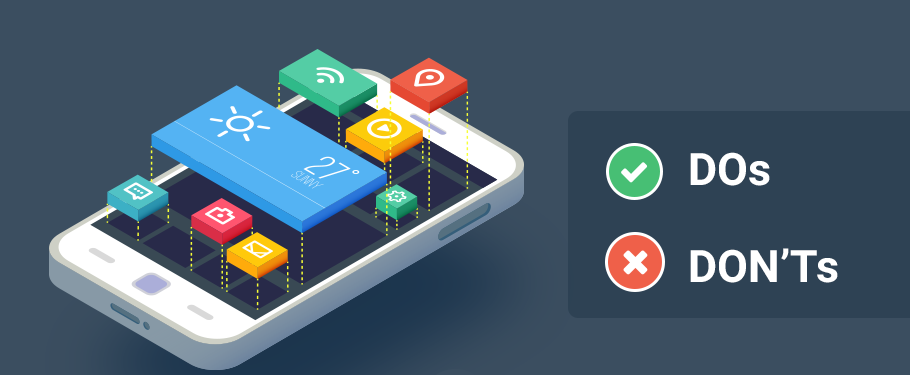
UX design is an incredibly complicated process requiring great skill and intelligence. As Nathaniel Hawthorne famously said, “Easy reading is damn hard writing,” and UX design is no different. A UX designer needs vast amounts of UX research knowledge to effectively move a user through the journey from point A to point B with the least effort and confusion possible.
UX design requires immense effort, comprehension, and analytical thinking, which can only be achieved over time by understanding best practices, trends, and techniques. It’s certainly not something you can master in an afternoon! So, with that in mind, we have compiled a list of do’s and don’ts when it comes to UX design to help those who are just starting.
The Do’s of UX Design
1. Do: Understand the End User Deeply
UX Design 101: Put the user comes first. This is perhaps the most fundamental UX design advice out there. This means from the very beginning, and it is necessary to have a thorough understanding of what users need and wants, as that is ultimately the purpose for why a product was created. UX Design should enable users to achieve their desired results easily and seamlessly, so comprehending the end-user deeply allows UX design teams to create something of quality that suits their needs.
UX practitioners must start from the beginning by conducting research and gathering an understanding of the users’ wants, needs, and pain points to create effective solutions that meet their expectations. Engaging with them helps UX professionals better understand how they interact with your product. Doing this will allow UX designers to offer creative solutions concerning their requirements and increase user satisfaction.
2. Do: Define Its Purpose
UX design is about creating digital products with a well-defined purpose that solves an end-user problem. This may be a special feature (commonly when dealing with an app) or a unique piece of content (when dealing with a website) – one specific thing that makes it stand out from the crowd. While it may be tempting, introducing multiple features or pieces of content can make a UX design overloaded and ineffective; this can lead to usability issues and turn away users. There are other reasons why this may not be a good path.
- Survivorship bias. UX designers can sometimes fall into the trap of survivorship bias. Defined as “the logical error of concentrating on the people or things that made it past some selection process and overlooking those that did not.” For example, Facebook is a successful social media platform with millions of users worldwide and thousands of different features. It’s easy to look at Facebook and think it’s always been successful. However, that is far from the case. Whatsmore, hundreds of other social media platforms have tried to emulate Facebook and failed.
- Curse of knowledge. UX designers are all too familiar with the Curse of Knowledge. This cognitive bias dictates that an individual’s use of knowledge and experience can blind them from perceiving the same situation from a less informed perspective. UX designers have often invested time and effort into building a product or service, knowing it intimately, making it difficult to consider user experiences that would otherwise feel out of reach. To be successful with UX design, designers must avoid this bias and focus on the initial hook factor for users.
In short, focus on crafting one unique element in your UX design that will result in maximum impact, connecting you with your target audience easily.
3. Do: Make Everything Work the Same Across All Devices
UX designers have an ever-increasing challenge as the use of digital devices has skyrocketed in recent years. A 2020 survey revealed that the average American household had access to more than ten connected devices, changes that UX designers must keep in mind when building products.
Thus, UX design requires a multifaceted approach to ensure consistency, no matter how the product is accessed – on a laptop, tablet, or phone. Building products with multiple device platforms in mind can present formidable difficulties. Still, UX designers must devote resources and energy to ensuring these experiences remain unified across all devices.
The Don’ts of UX Design
1. Don’t Confuse UX with UI
UX and UI are not the same, although they are often confused.
- UX (User Experience) is a broad concept encompassing the entirety of a user’s journey with something. UX focuses on providing an enjoyable and effortless experience through research and UX Design. UX can help increase the usage of a product or service and understand how it could be improved.
- UI (User Interface) focuses more specifically on the interface users interact with while undertaking their journey. It covers the look and feel of the visual aspects, such as colors, fonts, and icons, and ensures that all elements are laid out logically and strategically.
Both UX and UI are important parts of creating good user experiences and must work symbiotically together; UX helps guide where UI should be placed to ensure that it is easy to use.
2. Don’t Make Navigation Confusing.
It is amazing how often website and software builders forget the importance of user navigation. An amazing new feature or unique content may bring people in initially, but if they can’t find their way around assessing the product, they won’t stay. It’s a simple concept – easy access means more users and longer use; interrupted paths mean lost customers. However, so many glaringly overlook this basic fact in their designs. A good navigation system needs to be an integral part of any design or build process, or else all the features in the world will count for nothing.
Understanding the main feature and content you want to offer is the first step in overcoming the user engagement issue. This feature should be showcased prominently, making it quick and easy for users to find. Furthermore, the number of clicks, taps, and steps between each point should be minimized to avoid disorientation; attempting to predict where a user may go next can also help streamline navigation. Finally, always consider efficiency when guiding users from one end goal or task to another, such as presenting step B before going straight to step C instead of vice versa.
3. Don’t Put Aesthetics Over Functionality
User Experience encompasses much more than aesthetic appeal; it is a multifaceted approach to design that considers the real-world needs of users to create intuitive and accessible products. This is why minimalistic designs have recently enjoyed a surge in popularity – such designs focus on streamlining the user experience without getting lost in flashy embellishments. UX revolves around how usable, helpful, or enjoyable a product or service is for its intended audience. The appearance matters far less, so if functionality isn’t working optimally, no number of visual improvements can compensate.
Ideally, designers should bear aesthetics and functionality in mind by creating ‘functional beauty’ – seamlessly blending visuals and usability to craft something that looks good while providing an efficient interaction between the user and the product. Functional beauty sets user expectations while also providing a rewarding aesthetic experience. Combining these two elements creates an engaging User Experience that builds customer loyalty and helps strengthen relationships with users.
Conclusion
UX design can be challenging because it focuses solely on users, their comfort, and their needs. User-centered designs must be innovative, intuitive, and visually appealing, requiring ample research and practice. If you are entering the world of UX design, these do’s and don’ts are essential to your success in making designs that put users first. However, learning through trial and error will also lead to great success as you develop a greater understanding of user interactions and preferences. With a consistent effort over time, mastering UX design is possible.






